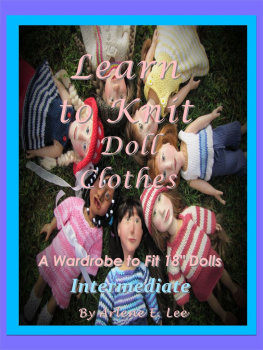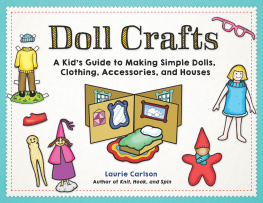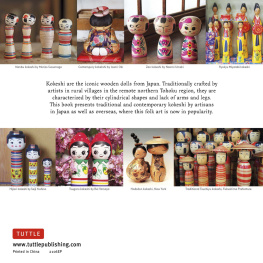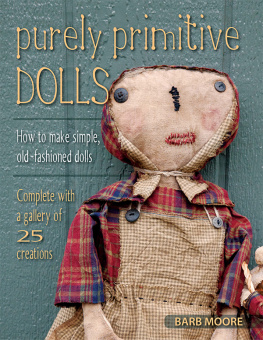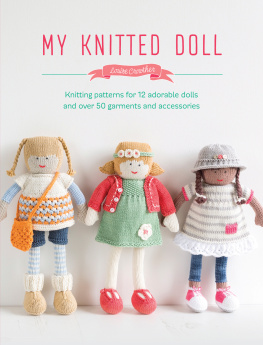Acknowledgments
First and foremost, I must thank the collectors who are listed here largely in itinerary order: Laddy Norwood, Cathy Kaplan, Leona Baylarian, Michael Ayervais, Judy Prince, Marv and Flo Herring, Donald Rupnow, Michael Nolledo, Austin George, Alan Levin, Jennifer Kohn, Judy and Joel Rosen, Vickie Hannig, Jack and Susan Lapin, Barbara Marshall of the Toy and Miniature Museum of Kansas City, Jim Eng, John and Laurie Fairman of Honeychurch Antiques, and Glenn Richards of Seattle, Lesal Ruskey, Erica and Evan Chahal, Edward Moreno, Susan Goldberg, Itske Stern, Donna Loesch, Anne Mears, and the indomitable Martha Longenecker Roth of the Mingei International Museum. Additional collectors for which I want to extend my debt of gratitude for their enthusiastic cooperation include Joe Lynch, Phyllis Kransberg, and Neville Tuli.
Exploring the history of private collections was a challenge of a different sort, but equally rewarding. I would particularly like to thank Mary Thomas Justice for her magnanimous loan of the Thomas family photo album compiled during her parents stay in Japan in the late 1940s and early 1950s. Replete with newspaper clippings, personal and professional photographs, it was a time capsule of incalculable value. I would like to thank Elizabeth Ann Coleman for her willingness to share documents from the Pryor Collection entrusted to her by June Anderson Douglas, former curator of the Pryor Doll Library. For information on the Adeline Collection, I would particularly like to thank Stephane Rioland of Paris for his willingness to share his discovery of a previously unpublished photograph of the gosho-ningy "Mikika"; Philippe Meunier and Jean Alonso Defrocourt, the undisputed kings of Majolica ceramics, for their hospitality and dedicated assistance in Paris in tracking down many fugitive details concerning Jules Adeline and the ultimate disposition of his collection; Chrystelle Dupuis for her personal observations regarding the contemporary world of traditional ningy manufacture in Kyoto; Gabriel Weisberg for his suggestions and insights on Japonisme and its early key players in the Paris art scene; Christies of New York; Richard Wright, a formidable expert on antique French dolls and resident doll expert for the Antiques Road Show television program, for his personal experiences regarding the Pryor Doll sale at Sothebys; and a special thanks to Audrey Fanning of Dolls Etc. for her patient explanations on the vicissitudes of the Western antique doll market.
In Japan, I would like to thank Asahara Kakuyo, not only for allowing me to use images of her collection but also for the many pleasant hours spent in her company and the ardent group of ningy collectors which surrounds her. Also Nishizawa Hsui, daughter of Nishizawa Tekiho, former curator and director of the Tekiho Memorial Museum, for sharing many personal memories of her father and allowing me to see in person the sculpture of the "Gangu san ketsu" described on page 25 which she keeps in her private collection. Though she always directs the focus back to her father, the efforts of this wonderful woman to preserve that important legacy should not go unremarked and unapplauded. Amemiya Toshiko for her translation assistance, document procurement, and general footwork without which the writing of several sections of this book would not have been possible. The staff at Yoshitoku Doll Company in Tokyo, particularly Kobayashi Sumie and Hayashi Naoteru of their research division, for their help in identifying the End Takeshi photographs, published here for the first time, and the current location of some of the figures pictured, as well as their rapid response to a scattered array of questions regarding ningy artists, the history of Yoshitoku itself, and permission to once again reprint some of the documents housed in their extraordinary collection. Saito Emiko of the Tokyo Ichimatsu Ningy Museum for her encouragement; her insights into the world of the ichimatsu - ningy artists of the 1920s and 1930s were of inestimable value. In Kyoto, as always, I would like to especially thank Tazawa Tsuguo for his perspective and opinions on many of the perplexing questions still surrounding ningy history. ki Heiz of Maruhei in Kyoto, once again, for his patient listening to my endless stream of questions and for sharing his intimate and keen insights into the world of traditional Japanese ningy . Tanaka Masaru of Hkyji Temple in Kyoto for his generosity of spirit and his willingness to share his personal collection of uji-ningy . And Yanagi Takashi for generously sharing with me his phenomenal eighteenth-century screen depicting a Hina-matsuri celebration and allowing me to publish it in this volume.
In all of my projects, the willing cooperation of museums around the world has made life much easier and my books much richer. I would like to thank Fujimoto Keiko of the Kyoto Cultural Museum for information concerning the Yoshikawa Kampo collection; the Art Museum of the Kyoto City University of Arts for allowing me to reprint images of Yoshikawa Kampos hakata - ningy ; the Hakataningy bike kogeshya in Hakata for their enthusiastic welcome and assistance in identifying some of the important artists in this medium; the Kumamoto City Museum and Tokyo National Museum for their generous permission to publish images from their respective collections. In the United States, I would like to thank in particular Gerald Marsella of the Peabody Essex Museum; the Rosalie Whyel Museum of Doll Art; the Cincinnati Art Museum; the Montana Historical Society, and the Cantor Arts Center at Stanford University. In France, the Bibliotheque Municipal de Rouen was very helpful in trying to locate archival images of the Adeline Collection.
As always, I would like to thank Masato Nishimura of the University of California in San Diego for his peerless translation work on Edo-period documents as well as more contemporary writings; Christine Hottinger for her unflagging support and role as computer expert, trouble-shooter, friend, and confidant; Melissa Rinne, Assistant Curator of Japanese Art at the San Francisco Asian Art Museum, for serving as a critical sounding board, key translator for some of the more obscure textile-related terms, and general bonhomie; Nancy Equall from the ICAL/ Physics Department of Montana State University for translating the test results from the gofun samples into intelligible English; my many friends in Japan; Catherine Ludvick (an inspiration), Maya Hara, Tazawa Etsuko, Axel and Kaho Michaels; Shirlee Funk for sharing some of the results of her exhaustive research into ningy - related terms; Linda Miller for once again agreeing to subject herself to the task of proofreading and for her many suggestions to elevate the quality of this work; Noor Azlina Yunus from the Periplus Publishing Group, a wonderful editor; Mary Flanagan Pate (Mom) for the many evidences of love and support throughout this project and life in general; and, last but never least, Robert Capriccio, my partner in life, to whom I lovingly dedicate this book.

Bibliography
Interviews
Interview with ki Heiz, Kyoto, December 12, 1997.
Interview with Tanaka Masaru, curator of Hkyji Temples doll collection, February 11, 2006.
Interview with Gerald Marsella, curator of Japanese Art at the Peabody Essex Museum, Salem Massachusetts, October 13, 2006.
Interview with Kobayashi Sumie and Hayashi Naoteru, Yoshitoku Doll Company, Tokyo, February 10, 2006.
Interview with Nishizawa Hsui, daughter of Nishizawa Tekiho, curator and director of the Tekiho Memorial Museum, March 22, 2002 and February 12, 2006.
Interview with Richard Wright, October 16, 2006.


